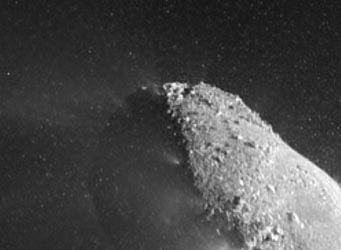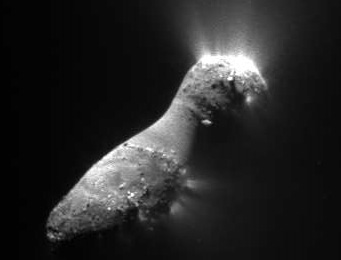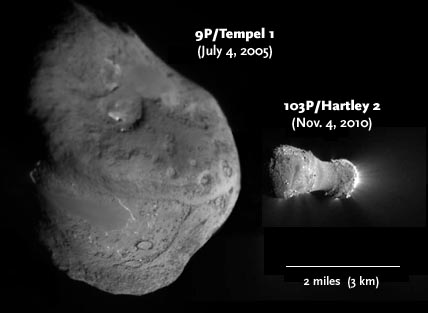When the Deep Impact spacecraft swept past Comet 103P/Hartley 2 two weeks ago, coming as close as 435 miles (700 km), mission scientists quickly pulled together some snapshots from the flyby to appease an eager and curious public. But all along they knew that better, sharper images, along with details of the comet's composition, would come in the days and weeks ahead.
Yesterday, during a televised press conference, they tipped their collective hand a bit more. Newly released images from the High-Resolution Imager (some of which needed a computer's help to sharpen details) show that this icy interloper is remarkable in many respects. For example, for the first time investigators can match individual jets of gas and dust to their sources on the nucleus.

When it flew past Comet Hartley 2 at close range on November 4, 2010, Deep Impact used its High-Resolution Imager to capture a blizzard of icy particles enveloping the shadowed end of the nucleus. Note the many active jets, being driven by the rapid release of carbon-dioxide vapor.
NASA / JPL / Univ. of Maryland
More remarkably, the spacecraft's images reveal that Hartley 2's effusive jets are propelling discrete chunks of matter, inches to a few feet across, that surround the nucleus and are moving slowly outward from it. "It looks like a snow globe that we've shaken in space," comments investigator Peter Schultz (Brown University). "The nucleus has a posse of mini-comets around it."
So was the spacecraft in danger? Stereo views reveal that many of the chunks were much closer to Deep Impact than to the nucleus. But apparently they're little more than fluffy aggregates — fractal clumps of tiny individual grains no more than 0.2 milligram in mass.
According to Tim Larson, project manager at the Jet Propulsion Laboratory, a careful analysis suggests that nine of these little flecks struck the spacecraft during the 10 minutes it was closest. They hit with enough kinetic energy to jiggle the structure momentarily but not enough to damage it. Investigator Jessica Sunshine (University of Maryland) agrees with that assessment, concluding that the particles' sizes are in the range of 1 to 10 microns. "We're seeing fluffy aggregates of very small pieces of ice, akin to a dandelion puff," she explains.

A close-up image of the nucleus of 103P/Comet Hartley 2, taken on the morning of November 4, 2010, by NASA's Deep Impact spacecraft. Note the numerous jets of gas emanating from the elongated body.
NASA /Univ. of Maryland
Of potentially greatest scientific interest, in fact a discovery that could turn current understanding of comets on its head, is the realization that the shower-head cascades of jets at both ends of Hartley 2 are not being driven by water vapor, as has long been thought. Instead, Sunshine says, "We now have unambiguous evidence that solar heating of subsurface frozen carbon dioxide — dry ice — is powering the many jets of material coming from the comet."
Ever since 1950, when the late Fred Whipple likened cometary nuclei to "dirty snowballs," cosmic chemists have believed water was the dominant volatile frozen into these icy bodies when they formed all those eons ago. Part of the problem has been an inability to detect CO2 gas directly: its strongest emission, at 4.26 microns, is too far in the infrared to be seen from the ground.
Only a few measurements of comets' CO2-to-H2O ratio have been made by spacecraft, and all are less than 10%, notes Mike A'Hearn (University of Maryland), the mission's lead scientist. (Japan's Akari space observatory reportedly has measured the carbon-dioxide abundance for about a dozen comets, but those results are still under wraps.)

The spectrometer aboard NASA's Deep Impact spacecraft recorded the appearance of Comet Hartley 2 at selected infrared wavelengths, revealing the distribution of key components in its jets and coma.
NASA / JPL / Univ. of Maryland
"Deep Impact had two major advantages that no one else has had," Sunshine explains. One was being able to watch Comet Hartley 2 continuously beginning about three weeks prior to the encounter. The other was getting close enough to resolve the individual sources of CO2 and H2O at both the sunward and darkened ends.
Yet water does play an important supporting role here. It's present in the plethora of CO2-driven jets at each end of the comet, and it appears to be oozing from the smooth-surfaced "waist" between them. In this sense, comments A'Hearn, Hartley 2's midsection resembles Deep Impact's earlier target, Comet Tempel 1. "Tempel 1 has ice 1 to 2 meters deep," says A'Hearn. "We know, because we excavated it."
The spectrometer also picked up the infrared signature of organic matter, which was not particularly surprising. When the Giotto spacecraft flew through the coma of Comet Halley in 1986, one of its instruments found that some 30% of the bits it analyzed were "CHON particles," consisting entirely of the organic building-blocks carbon, hydrogen, oxygen, and nitrogen.

The two comets visited by NASA's Deep Impact spacecraft, shown at the same scale. With a length of 4.7 miles (7.6 km), Tempel 1 is five times larger than Hartley 2. Yet visible jets were obvious in views of Hartley 2's nucleus, whereas those of Temple 1 could be glimpsed only after extensive image processing. Click on the image for a larger view.
NASA / JPL / Univ. of Maryland
Meanwhile, Deep Impact's cameras continue to snap away (one frame every 2 minutes) even as the comet recedes into the distance. The image count is already up to 32,000, and that will rise to more than 100,000 by the time this encounter wraps up late this month.
"And the mission is far from over. After Deep Impact's splashy visit to Comet Tempel 1 in 2005, it was recommissioned as the EPOXI mission, a contraction of its two new assignments: Extrasolar Planet Observations and Characterization (EPOCh), and this second cometary flyby, called the Deep Impact Extended Investigation (DIXI).
(Hmm… now that the DIXI part is over, I wonder if some jokester at NASA Headquarters will rename the mission again, perhaps to EPOXied?)
Read more about the encounter's results, and see more images, by checking out the press releases issued yesterday by NASA and the University of Maryland.
Now, about that spacecraft-identification challenge I tossed out two weeks ago…
I stated that Deep Impact's recent feat raised to five the count of comets imaged by a spacecraft at close range — the others were Halley in 1986 (Giotto, Vega 1, and Vega 2), Borrelly in 2001 (Deep Space 1), Wild 2 in 2004 (Stardust), and Tempel 1 in 2005 (Deep Impact).
I also noted that a sixth comet had gotten the up-close-and-personal treatment, though the spacecraft had no camera, and could anyone name it?
Well, I am humbled by your collective knowledge. As reader Frank Reed correctly pointed out, the count is actually seven, not six. He was the first respondent to list both the one I remembered (Comet Giacobini-Zinner, visited by the International Cometary Explorer in 1985) and the one I'd overlooked (Comet Grigg-Skjellerup, Giotto's second flyby, in 1990). Giotto did have a camera among its instruments, but it became inoperable after getting badly banged up during the Halley flyby.
So congratulations, Frank, and thank you for setting me straight!
 1
1
Comments
Michael C. Emmert
November 22, 2010 at 9:49 am
The CO2 result is very interesting, but I wonder if that can be generalized to all comets. Hartley 2's periheliion is greater than 1 A.U. so maybe it's not so surprising that lower temoperature volatiles should be detected, especially since Hartley 2 might have assumed this orbit relatively recently.
Some comets show cyanide, and I don't see any mention of (specifically) cyanide in the artice. The only relatively extensive comet observation I did was Halley's from a rural site with my stepfather's small binoculars and I easily saw it's cyanide tail.
We need more telescopes outside the atmosphere. Our learning curve is a little low right now.
-Michael C. Emmert
You must be logged in to post a comment.
You must be logged in to post a comment.